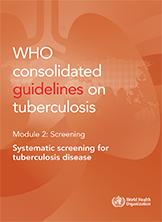2.5.2 Implementation considerations
A prisoner is anyone held in a criminal justice facility or correctional facility during the investigation of a crime, anyone awaiting trial and anyone who has been sentenced. In addition, people residing in a correctional facility are almost always in close contact with several other inmates; thus, whenever a person residing in a prison is diagnosed with TB, prisoners who have been in close contact with that person should be investigated (see Recommendation 4).
 Feedback
Feedback
